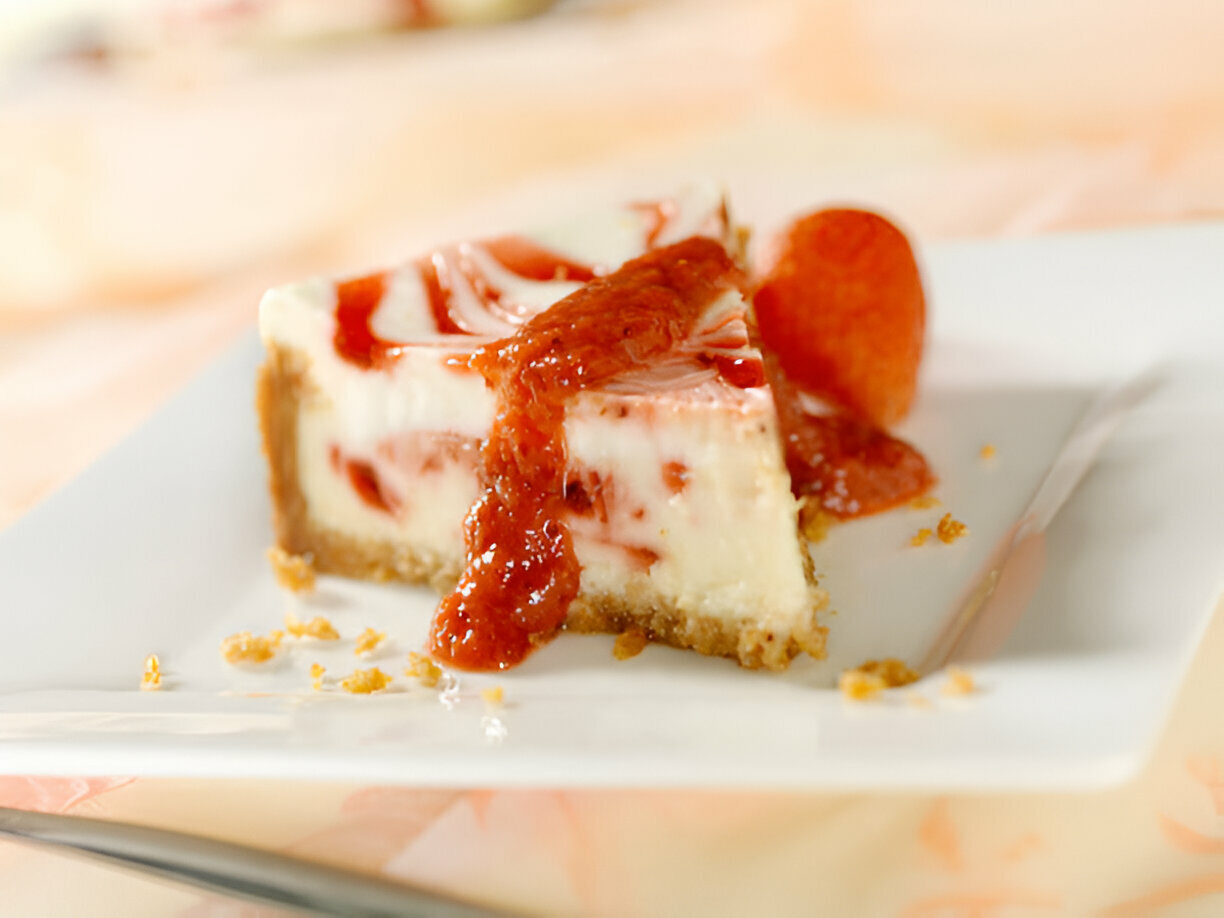
Strawberry Cheesecake Swirl Recipe
Velvety smooth cheesecake meets luscious strawberry swirls in this stunning dessert, perfectly balanced between rich creaminess and fruity sweetness. Each bite melts in your mouth, making it a delightful treat for any occasion.
Pin
Print
Save
Servings: 12
Calories: 450kcal
Ingredients
Crust
- 1 ½ cups graham cracker crumbs
- 5 tablespoons butter melted
- 1 ½ tablespoons granulated sugar
- Strawberry Sauce
- 2 ½ cups sliced strawberries
- ½ cup granulated sugar
Cheesecake
- 24 ounces cream cheese softened to room temperature
- 1 ¼ cups granulated sugar
- 4 large eggs
- 2 teaspoons vanilla extract
- 1 cup full-fat sour cream
- ½ cup heavy cream
Instructions
Crust
- Preheat your oven to 325°F (163°C). Lightly grease a 9-inch springform pan with nonstick baking spray, ensuring the sides are well-coated. Line the interior with a 3-inch-wide strip of parchment paper to help release the cheesecake cleanly after baking.
- In a medium-sized mixing bowl, combine the graham cracker crumbs, melted butter, and granulated sugar. Stir thoroughly until the crumbs are evenly coated, forming a moist, sandy mixture. Transfer the crust mixture into the prepared springform pan and press it firmly and evenly across the base, creating a compact foundation. Place the pan in the refrigerator or freezer to firm up while preparing the strawberry sauce and cheesecake filling.
Strawberry Sauce
- In a medium saucepan, combine the sliced strawberries and granulated sugar. Set over medium heat and allow the mixture to cook for 10 to 13 minutes, stirring frequently. As the strawberries soften, use a wooden spoon to gently break them apart, helping to release their natural juices and speed up the cooking process.
- Once the strawberries have softened completely and the mixture has thickened slightly, remove it from the heat. Transfer the cooked strawberries to a blender or food processor and pulse until the sauce reaches a smooth, velvety consistency. Set aside to cool while you move on to the cheesecake filling.
Cheesecake
- In a large mixing bowl, add the room-temperature cream cheese. Using a hand mixer on medium speed, beat the cream cheese until it becomes smooth and creamy, ensuring there are no lumps. Gradually add the granulated sugar and vanilla extract, continuing to mix until fully incorporated and the mixture appears fluffy.
- One at a time, add the eggs, beating each one just until blended before adding the next. Pause occasionally to scrape down the sides and bottom of the bowl, ensuring all ingredients are evenly distributed.
- Once the eggs are fully incorporated, gently fold in the sour cream and heavy cream. Mix only until just combined—overmixing at this stage can lead to a dense texture rather than the signature creamy consistency of a classic cheesecake.
- Before assembling, wrap the outside of the springform pan with two layers of heavy-duty aluminum foil to prevent water from seeping in during baking. Alternatively, place the cheesecake pan inside a slightly larger pan to protect it from water exposure, then set both inside a third pan filled with about an inch of hot water. This water bath method helps regulate the baking process and prevents cracks.
- Carefully pour the cheesecake batter over the prepared crust, smoothing out the top with a spatula. Transfer the cooled strawberry puree into a small sandwich bag, snip off a tiny portion of one corner, and pipe a swirl design over the cheesecake batter. Keep the tip just above the surface to maintain visible patterns.
- To enhance the decorative effect, use a skewer or toothpick to gently drag through the swirls, creating a delicate marbled pattern. Avoid excessive swirling, as this can disrupt the texture and lead to cracking.
Baking and Cooling
- Place the cheesecake in the preheated oven and bake for approximately 1 hour and 25 minutes. The edges should be set, while the center should still have a slight jiggle when gently shaken—similar to gelatin but not runny like raw batter. If the center appears too liquid, extend the baking time in small increments, checking frequently.
- Once baked, turn off the oven and leave the cheesecake inside with the door slightly ajar. Allow it to cool gradually in the warm oven, preventing sudden temperature changes that can cause cracking. After the cheesecake reaches room temperature, transfer it to the refrigerator and let it chill overnight. This extended chilling time ensures the cheesecake fully sets, resulting in a rich, creamy texture.
- When ready to serve, release the springform pan, slice, and enjoy the luscious blend of smooth cheesecake and vibrant strawberry swirls.
Nutrition
Calories: 450kcal
Did you make this recipe?Want more delicious recipes like this? Follow us on Pinterest for daily inspiration! Click here to Follow me on Pinterest @feaztcom